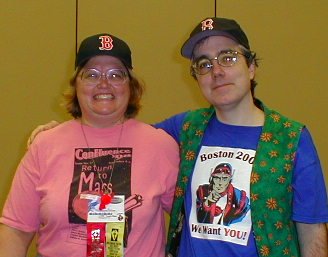Wake by Robert Sawyer
I continued my Hugo reading with WWW: Wake by Robert Sawyer. Sawyer typically does a good job of combining realistic and interesting characters with generally thrilling concepts, and Wake is no exception.
Caitlin a teenage math genius who was born blind. Her eyes work, but the signal is garbled on its way to her brain. A research scientist in Japan develops a possible solution: essentially an external signal processor that transforms the signal between retina and brain. The device -- which Caitlin calls her eyePod -- eventually works, but has a side effect. In one of its modes, it enables her to literally see the World Wide Web, which appears to her as geometric shapes connected by lines.
But in viewing the Web, Caitlin sees something else. There is an information-containing process in the background, a cellular automata. Information theory confirms that what she is seeing isn’t just noise, and it first she and those around her assume that it’s perhaps an NSA monitoring process. But it isn’t: an intelligence has developed in the Web’s information systems. She sees it, and it, following the info feed from Caitlin’s eyePod, sees her.
Sawyer does a very good job of showing how a Web entity -- which Caitlin comes to think of as the Phantom, based on a term Hellen Keller used to describe her own pre-aware state -- as bit by bit it becomes aware of itself and its surroundings. At first, it has no idea what the data all around it is. It “sees” ones and zeroes but has no idea what they mean. But by watching Caitlin and her attempts to teach herself to read after she gains sight, it begins to understand. And what Caitlin realizes what she’s dealing with -- an intelligence, not just background noise or an NSA process -- she helps it along, taking an active role in teaching it.
Equally well done is Sawyer’s portrayal of Caitlin, both as a person who has never been able to see and as a person who suddenly can see. He is very detailed in both parts. For example, when Caitlin gains her sight, she can’t read. Of course she’s been reading braille for years, and is a wiz on the Web, with a blog (under the name Calculass), and can write. But she has never seen letters, let alone words, so she must learn, but by bit, starting with “A is for apple” style primers. It’s watching her do this that helps the Phantom understand what the data streams are, as it relates the ASCII bit pattern for “A” with the picture of the apple.
Unfortunately from a Hugo voter’s perspective, the book isn’t complete. It’s really the first third of a longer novel. The major plot line at least comes to a reasonable pause point, but subplots are only partially developed. An interesting side story about a chimp that begins to paint in a representational fashion -- clearly a step toward awareness, in parallel with the main story -- isn’t really tied in and the last part of it we see in this book is a cliff hanger of sorts. I’m sure Sawyer will tie it in more strongly in the next two volumes, but form the perspective of just this book -- which is after all what I need to vote on for my Hugo ballot -- it’s incomplete.
So, even though I enjoyed Wake and plan to buy the next volume, it will be behind several other novels on my ballot.


0 Comments:
Post a Comment
<< Home